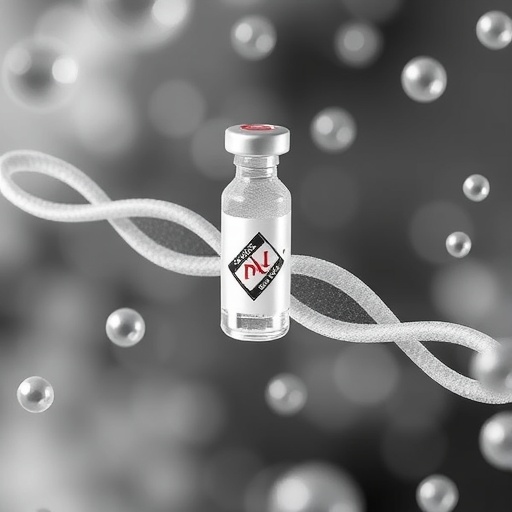In a breakthrough poised to revolutionize vaccine technology, researchers at the Massachusetts Institute of Technology (MIT) have engineered a novel lipid nanoparticle (LNP) that dramatically enhances the potency of mRNA vaccines while potentially slashing the dosage required per injection by a factor of one hundred. This advancement could not only decrease production costs but also reduce side effects, thereby making vaccines more accessible and tolerable on a global scale.
At the core of this innovation lies the strategic modification of the ionizable lipid component within LNPs. These lipid nanoparticles serve as crucial delivery vehicles, encapsulating fragile mRNA molecules and escorting them safely into cells. The MIT team’s approach focused on synthesizing ionizable lipids with cyclic amino alcohol structures, coupled with ester groups designed to improve biodegradability and facilitate rapid clearance from the body once their job is done.
Conventional LNPs, including those used in COVID-19 vaccines developed by Moderna, typically require relatively high mRNA doses to elicit robust immune responses. However, the newly engineered lipid nanoparticles developed by the MIT scientists not only facilitate superior intracellular delivery but also efficiently overcome the cellular barrier known as endosomal entrapment. Following cellular uptake, LNPs are sequestered inside endosomes—membrane-bound compartments from which the payload must escape to reach the cytoplasm and prompt protein synthesis. The MIT particles exhibited a markedly improved ability to escape these endosomal compartments, ensuring more mRNA reaches its target location within the cell.
Another salient feature of these novel LNPs is their biodegradability, a direct consequence of incorporating ester bonds into the lipid tails. This design ensures that after delivering their mRNA cargo, the particles rapidly degrade into biocompatible byproducts, potentially minimizing inflammatory responses and other adverse effects commonly associated with nanoparticle accumulation.
The researchers validated the efficiency of their particles in preclinical studies, utilizing an mRNA vaccine targeting influenza in mice models. Remarkably, the optimized LNPs—designated AMG1541—elicited antibody titers equivalent to those induced by vaccines formulated with FDA-approved SM-102 lipids, yet at just one percent of the dose. This dose-sparing effect has monumental implications for vaccine accessibility and manufacturing scalability, particularly in low-resource settings where reducing raw material costs is critical.
Furthermore, AMG1541 demonstrated an enhanced affinity for antigen-presenting cells (APCs)—key orchestrators of the immune response tasked with antigen processing and presentation to lymphocytes. The augmented delivery to APCs likely amplifies immune activation, fostering a more efficient and robust protective response against pathogenic threats.
Beyond efficacy, the novel LNPs preferentially accumulate within lymphatic tissues such as lymph nodes, which serve as immunological hubs housing diverse immune cell populations. This targeted biodistribution further potentiates the immunostimulatory capacity of the vaccine by concentrating mRNA delivery where it most effectively triggers adaptive immunity.
An additional noteworthy advantage offered by mRNA vaccines is their rapid scalability and adaptability. Unlike traditional flu vaccines that require nearly a year for production due to reliance on egg-based culturing and strain selection logistics, mRNA-based formulations can be synthesized swiftly once circulating viral strains are identified. The development of highly potent delivery vehicles like AMG1541 could expedite this process even further by reducing the amount of mRNA needed per dose, enabling faster, cheaper, and more precise immunization campaigns tailored to seasonal influenza variants or emerging infectious diseases.
While the proof-of-concept experiments were conducted with influenza antigens, the versatility of this LNP platform could extend to other viral pathogens including SARS-CoV-2, HIV, and beyond. The technology’s superior delivery efficiency and safety profile make it an attractive candidate for a new generation of vaccines capable of addressing some of the most pressing infectious disease challenges.
Dr. Daniel Anderson, senior author and professor at MIT’s Department of Chemical Engineering, emphasized the broader implications of this work, highlighting how dose reduction can transform the economics and side effect profile of mRNA vaccines at a population scale. His team’s collaboration combined expertise spanning chemical engineering, immunology, and nanomedicine to achieve this feat, underscoring the interdisciplinary nature vital for advancing vaccine science.
This landmark study was published in the prestigious journal Nature Nanotechnology on November 7, 2025. It represents a significant leap forward in the field of vaccine delivery systems, demonstrating that rational lipid design informed by chemical structure-function relationships can overcome longstanding barriers in mRNA therapeutics.
The research received funding from Sanofi, the National Institutes of Health, and the Marble Center for Cancer Nanomedicine, alongside support from the Koch Institute at MIT. The lead authors, including Arnab Rudra, Akash Gupta, and Kaelan Reed, contributed key insights and experiments that paved the way for translating these novel lipid nanoparticles from bench to potential bedside applications.
As the world continues to grapple with emerging pathogens and seeks improved methods to control endemic infectious diseases, innovations like AMG1541 herald a new era in vaccinology. By enabling highly potent, dose-sparing, and rapidly deployable mRNA vaccines, such advanced lipid nanoparticle platforms could be pivotal in safeguarding global health against future pandemics.
Subject of Research: Development of enhanced degradable lipid nanoparticles for efficient delivery of influenza mRNA vaccines.
Article Title: Degradable cyclic amino alcohol ionizable lipids as vectors for potent influenza mRNA vaccines
News Publication Date: 7-Nov-2025
Web References: DOI: 10.1038/s41565-025-02044-6
Keywords: Vaccine development, vaccine research, life sciences, health and medicine, infectious diseases, influenza




